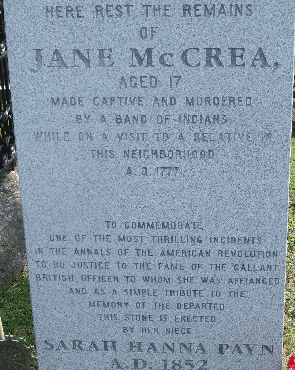Jim McMaster forwarded this along about the Friends of Historic Huletts grand opening party of their new gallery and library – which was a great success. It was well attended by about 100-150 people, there was lots of looking at the exhibits and much general satisfaction with the way the place looked. The back yard worked well for wine and snacks. Even the mosquitoes cooperated and stayed away!
The Battle of the Harbor Islands
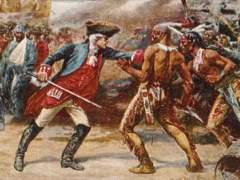
I have heard periodically that British soldiers are buried on the Harbor Islands owned by the Paulist Fathers.
This small historical reference about the Islands gives some context on how this may have occurred.
“This group of 5 privately-owned islands in Lake George is located a little over 2 miles south of Sabbath Day Point. A significant and bloody battle occurred on the islands during the French and Indian War. On July 5, 1757 Col. John Parker, on a scouting mission from Fort William Henry, was camped here with some 350 British troops. An engagement took place between the British force and some Indians allied with the French. The British force was slaughtered- of the 350+ troops, only 12 escaped. Reportedly, 131 British soldiers were killed, with the remainder taken captive. In those days, it should be noted, it was often preferable to die in battle than to be taken prisoner by Indians.”
I’ll be doing some research on this in the weeks ahead to see what else I can learn.
License to Steam
I was not aware of this, but at one time it was necessary to obtain a license from NY State to pilot a steam boat. Recently, Gordon B. Foster provided me with a copy of his grandfather’s license which enabled his grandfather to be a pilot and an engineer on a “steam motor vessel”.
This is one of the more interesting pieces of memorabilia that I have seen. It was issued August 13, 1924 in the name of Fred L. Foster and designated that Lake George was the body of water where the vessel could be operated.
I never knew there was an office of Inspectors of Steam and Motor Vessels.
Now for Some History: 1609

“Defeat of the Iroquois at Lake Champlain,” July 30, 1609 (which happened near Ticonderoga) is the only known likeness of Samuel de Champlain to survive from his own time. (Library of Congress)
2009 is the 400th anniversary of the discovery of Lake Champlain by the man whom it is named after. There are many local celebrations taking place this summer in recognition of this event.
Champlain is best remembered for his role as an explorer, map maker, and as a prolific writer but many facts about him have been lost to history.
However, we can gleam some historical clues into the life of Champlain from the small image above.
Champlain stands in the center wearing armor and firing an arquebuse a rouet, which was a very advanced model of a very sophisticated weapon for that day. Two french soldiers appear at the top of the engraving. On the left we see a small number of Algonquin warriors attacking a larger band of Iroquois of the Mohawk nation.
The plumage he wears is the sign of an officer of high standing. Some historians even speculate that he may have been the illegitimate son of Henri IV of France. The helmet he wears is usually seen in equestrian drawings, so some historians surmise that he was familiar with horses.
The alliances depicted in the engraving would stand for approximately the next 150 years. The Algonquin would side with the French and the Iroquois would team with the British in the battle for North America which would continue over the next two centuries.
Champlain is regarded as one of the few explorers of North America who believed in treating the Indians humanely and with respect. He was also a naturalist. He loved the plants and animals he encountered in the new world and wrote extensively on what he encountered.

To learn more about Samuel de Champlain I would highly recommend the book; Champlain’s Dream by David Hacket Fischer, which I am working my way through slowly. It is an exquisite history of the man and the founding of New France.
So now the next time you cross Lake Champlain on your way to Huletts, you’ll be able to say that you’ve seen the only likeness of Champlain which is judged by historians to be authentic and which survives from his time.
An Interview with Jim McMaster
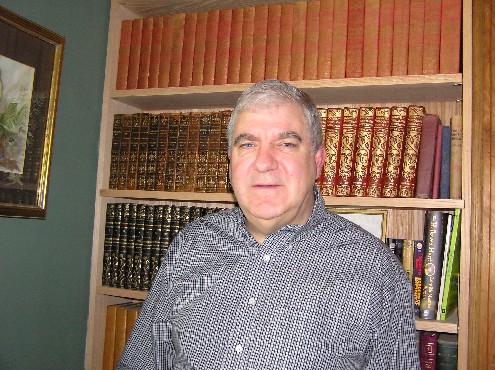
Today, I had the opportunity to sit down with Jim McMaster who is the President of the Friends of Historic Huletts Landing (FHHL).
FHHL has leased the old firehouse and is making renovations to turn the building into a community resource building.
“Jim to begin could you tell us about some of the events FHHL has planned for this summer?”
The biggest effort for FHHL this year has been converting the old Huletts firehouse building to serve as a better home for our collection, as well as to keep the Mountain Grove Memorial Church Ladies Guild Library in operation. We have a tentative name, “Huletts Gallery and Library” that we hope people will find more inviting and will give a greater sense of community ownership to residents as well as renters. We would also like to see if it can serve as a gathering place for at least some community activities. The commitment for this activity will absorb more money that we have received from donations alone in the past, so we will necessarily have to put more emphasis on membership and fundraising, but hopefully not so much that it is an annoyance.
“When you say that FHHL is turning the building into a community resource could you tell our readers some of the things you were thinking about doing in the building?”
We have several objectives.
First, FHHL has housed its small collection there for years, but the display space was very limited and not well maintained. Over the years since FHHL was formed, we have saved and invested much of the money donated. As a result of the efforts of the people who came before me, we had enough money to make some small scale renovations possible. We have done several things that we hope will be well received. With the help of JVP Landscaping, we have removed the undergrowth and eyesores from behind the building and have filled and graded to provide what we hope (mosquitoes cooperating) will be a nice gathering place for Summer activities, like art shows and receptions. The area is actually rather nice and has a couple of large tree boles as well as the stream that make it interesting. We rip-rapped along the stream and hope to plan some perennial cover between the stones to make it even more erosion resistant. To protect Foster Brook we added a gravel walkway so entry via the new back door is easy from either side of the building. Hopefully we can add a chair or bench out there, and volunteers will plant some nice perennial plants. Inside, we have repainted the walls (after filling about 10,000 nail holes) and the woodwork. We even washed the curtains. We are building several shelf-display panel combinations and a couple of 4 ft x 8 ft display boards to provide lots of space for graphic collection. These will provide space for at least 80 large scale prints. We hope to place these inside the building to leave much of the wall space available for hanging of more permanent framed items. We have had several donations this year and will also frame a few items from our collection.
Judy Haggert let us scan some of her Huletts and Lake George postcard collection and also some historic photos of the hotel and ice gathering, for example. We have made large size posters of these to provide an initial display. Our hope is that members of the community will get interested enough to loan us historic pictures from their own collections for scanning or photographing so we can use these for theme display in the future, as well as add to the FHHL website (www.historichuletts.org).
Second, the Mountain Grove Memorial Church Ladies Guild) has operated a free library in the building for several years. They have been limited by shelf space to maybe 2500 to 3000 books, mostly paperbacks, but a few hard covers. We are adding free standing shelves to roughly double that number. We hope that the hours of operation (now Tues. and Thurs. 10 to 12) can be increased (volunteers needed) and that that will double to provide access to the FHHL Collection as well. The Guild will be looking for book donations to fill all those new shelves. It is important that people understand that the library is for both owners and renters in the community. Those who have a renter manual might add mention of the availability of the gallery and library. Current hours are Tuesday and Thursday, 10 am to noon, but access at other times can be arranged. We hope to install a book drop in the overhead door of the equipment bay to make it easier for people to return (or donate) books as they leave the landing.
Third, we hope to create a small space for community gatherings (not that the new firehouse isn’t pretty nice).
We are planning an informal wine and cheese reception from 5 to 7 pm on July 15 to sort of introduce the Gallery and Library to the community. Weather permitting, we’ll try out the new backyard for part of the activity. The display and library enhancements may not be completely finished, but we hope to have enough that people can see where we are going. Of course, we’ll have a cookie jar for donations and membership forms for those interested.
“You’re also going to have some unique speakers come in and talk about regional history. Could you give us a brief preview of what is in store?”
We have typically had a couple of summer programs in the evening at the Mountain Grove Memorial Church. These have been interesting and educational, but haven’t reached too much beyond the older generation of citizens. This year Lucy White, FHHL’s Program Director wanted to have at least one additional program and to try to extend the reach to a wider range of the community as well as to younger people, and I think has succeeded.
Lucy has arranged two traditional evening programs:
Captain Paul Saenger, Captain of the Carillon cruise boat running out of Whitehall will share stories and pictures of the history of this most interesting region. Many people may know, Wood Creek provided part of the water connection between the Hudson and Lake Champlain. Early trails followed the creek, followed by the canal, which was subsequently widened and deepened to what you see today. Railroads also followed the route due to the easy grade. As a result, Whitehall was for many years a very important terminal for commerce. This interesting talk will take place, July 19th at 7 pm, in MGM church.
Marian Knight and Ginny Lyons will present a program exploring the history of the Knight family, longtime residents in Huletts. They will share family photos, stories, and memories. This will take place, August 21st at 7 pm, MGM church.
Sylvia Lawler is also putting together a night of Celtic Music that includes “Road to Galway”, a Celtic band that sounds fun (Google them and look at the U-Tube piece). In addition Huletts’ own Elizabeth Straton, Betsy to many of us, will sing. I’ve had a couple of her CD’s for several years and enjoy them a great deal. The Celtic Night will be at the Casino on July 25th from 7 to 11 pm (and a bit longer if the band keeps playing). This will be a good opportunity to visit the Casino. It you want to come early for dinner, it would be a good idea to make reservations with Leann at the Casino a few days ahead so that she can have enough help and food to serve those who come. Tickets are on sale at the Casino and the Marina, as well as from Sylvia at 518-756-2631, $10. ($12 at the door) for adults, $5 for children 6 to 12, and children under 6 free.
Lucy, is also planning to have some sort of Children’s Program in August. We hope to have an area in the “Gallery” arranged for children’s books and activities. Lucinda (Heidsiek) Bhavasar and Pam (Judge) Wilson are putting this together. Contact them if you want to help.
“All of those things are very exciting, how can our readers get in touch with you and support FHHL?”
We are hoping to increase our current 66 paid member families (last year’s total) to at least half of the 300 families listed in the Huletts Directory. We used mailing lists this year for the Newsletter in hopes of reaching a wider audience, and hope that anyone on the FHHL list we managed to leave off will forgive us. We hope this web presence will help as well. Membership forms will be available at the Gallery, or just give your coordinates, including E-mail to a member, along with your dues, and we’ll sign you up. Finally, if you rent, be sure to let your renter’s know that these programs are available to them.
“I know what you’re doing would not be possible without the generous arrangement the fire department made with FHHL, to lease you the building. Could you tell our readers how this came about and who we should thank in the fire department for making this happen?”
Certainly FHHL is grateful to the HLVFD for leasing us the building, but it is hopefully a win-win situation for HLVFC, FHHL, and the community. We had a debate over the past couple of years inside FHHL as to whether we could do this from a financial point of view, and particularly during a time of recession. However, the building was available now, and might not be in the future. We were concerned about the cost of major repairs, like, say the roof needed replacement. But, if you think about it, the fire company would have to turn to the same community that we will turn to when this become necessary. Just different people doing the begging.
We had sufficient money in the FHHL treasury to finance this with no external help or grants, although we do hope to use the fledgling Gallery as a tool to obtain such grants in the future, mainly then to improve, expand, and protect the collection.
“What do you plan for FHHL in the future.”
We laid out 5 objectives for this year. Do something with the old firehouse, arrange a third program, increase the content on our website, enhance our physical image collection, and try to get one grant. We are on track for this thanks.
For 2010, we have some basic ideas. So far, No. 1 is to expand our physical collection. No. 2 is to increase community participation, not just with membership, but also with volunteer help on projects, as hosts for the gallery and library so we can extend the hours. We will round out a list of 5 or so by the August 22 (note this date might change) FHHL Annual Meeting, which will be at 9 am at the Gallery.
“What can the community do to help?”
We would like to see greater involvement in what we are doing, as well as increasing the paid membership to provide the increased funding we will need to do this right. Not just Huletts, but all of Dresden residents. “Support, Join, Participate” sort of sums up what we hope our community will do.
“Jim, it’s been a pleasure chatting with you and learning about FHHL. Thank you for all you’re doing and keep up the great work.”
Historic Huletts Beer Can Art

Many people may remember longtime Huletts resident, Frank Nelson, who passed away sometime in the late 1970’s or early 1980’s. He lived past the entrance to the Mountain Grove Memorial Church.
I came across these recently and thought they’d make an interesting story. One of Mr. Nelson’s hobbies was making artwork that resembled miniature furniture out of beer cans. These were some of the pieces he gave to me when I was younger.
He basically took a beer can, cut it and twisted it and added padding for the seat and turned it into a miniature furniture set.

I took two shots of the same pieces below. Here is what the finished product looked like.

Here you can clearly see the bottom of the beer can under the padding.
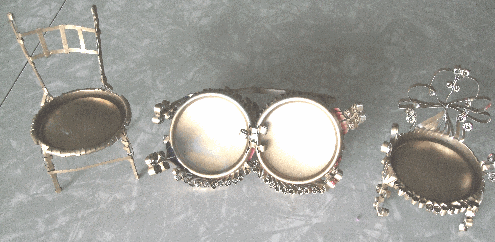
Many people in Huletts probably have some of these pieces still around but it’s a great example of taking everyday garbage and making something useful and artistic out of it. The funny thing is, Mr. Nelson actually told me; “Hold onto these, someday they’ll be worth something.”
If you have any beer cans left over from the 4th, you can try it too! It proves the old axiom, “that one man’s garbage is another man’s treasure!”
Who Was Jane McCrea?
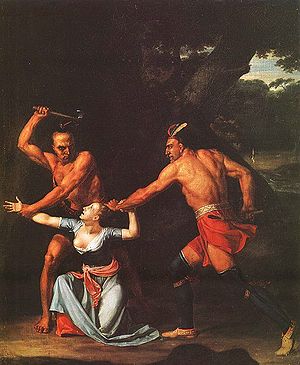
This painting by John Vanderlyn is a depiction of the murder of Jane McCrea on July 27, 1777.
If you stand at the entrance to the Washington County Building in Fort Edward and look across the street, you will see this sign.
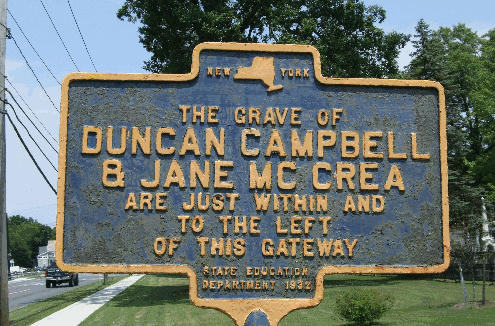
If you then proceed through the gate and into the cemetary as the sign directs you, you will see the grave and tombstone of Jane McCrea. (I posted a full resolution picture if you click on the image below.)
This leads to the title of this post; who was Jane McCrea?
The sad irony is that Jane McCrea was a Loyalist murdered by Indians under the command of the British as she was going to see her British fiancé. It illustrates that in war sometimes it is unclear what side a person is on. Her death backfired on the British because it inspired the resistance to Burgoyne’s invasion leading to his defeat at Saratoga.
McCrae was born into the large family of Rev. James McCrae of New Jersey. Since her father’s death she had been living with her brother John near Saratoga and had become engaged to David Jones. When the war began two of her brothers joined the American forces while her fiancé fled with other Loyalists and joined the British army. Jones was serving as a lieutenant in one of the Loyalist militia units which was stationed at Fort Ticonderoga.
McCrea left her brother’s home and was traveling to join her fiancé at Ticonderoga. She had reached the village of Fort Edward. She was staying at the home of Sara McNeil, another Loyalist and an elderly cousin to the British General Simon Fraser.
On the morning of July 27, 1777, a group of Indians that were moving in advance of the main British force on their way to Saratoga, descended on the village of Fort Edward. They massacred a settler and his family, and then killed Lieutenant Tobias Van Vechten and four others when they walked into an ambush.
This same company of Indians then also raided the McNeil house, taking Jane and Mrs. McNeil hostage. As they withdrew, the two women were separated and Jane was murdered.
There are conflicting accounts of her death. The traditional version has it that two warriors quarreled over who would take her in for an expected reward thinking she was on the side of the Americans, and that one of them killed her with a tomahawk to settle the issue. Another account is that she was killed by a bullet from the Americans withdrawing from Fort Edward. This second version was claimed by the warrior who had her scalp, presumably to avoid punishment when questioned by General Fraser.
When Burgoyne heard of the killing he went to the Indian camp and ordered the culprit to be delivered, threatening to have him executed. He was told by General Fraser that such an act would cause the defection of all the Indians and might cause them to take revenge on the Britsih as they went back north. Burgoyne relented, and no action was taken against the Indians.
News of Jane’s death traveled quickly and became exaggerated and incited American resistance because of her horrible murder.
In the end the murder of Jane McCrea was a historical turning point in the Revolutionary War because it turned public opinion further against the British.
So the next time you’re at the Washington County Center in Fort Edward, venture across the road and pay your respect to the young lady buried there.
(The above was condensed from online sources.)
20 Years Ago Today

Where were you 20 years ago today? Well July 1, 1989 was the day the Casino reopened after being closed for 16 years. That’s right. Between 1973 and 1989 the Casino was closed.
Al Kapusinski spearedheaded the effort and while the Casino has gone through a couple of reincarnations over the last few years, he was the one who got it going again in 1989.
Al is doing well and sends his regards to everyone. He’ll be back in Huletts in a few days. So when you see him this summer, tell him you’re enjoying the Casino and it’ll bring a smile to his face!
First Day of Summer
In honor of the first day of summer I thought I would post
Shakespeare’s Sonnet 18
SONNET 18
Shall I compare thee to a summer’s day?
Thou art more lovely and more temperate:
Rough winds do shake the darling buds of May,
And summer’s lease hath all too short a date:
Sometime too hot the eye of heaven shines,
And often is his gold complexion dimm’d;
And every fair from fair sometime declines,
By chance or nature’s changing course untrimm’d;
But thy eternal summer shall not fade
Nor lose possession of that fair thou owest;
Nor shall Death brag thou wander’st in his shade,
When in eternal lines to time thou growest:
So long as men can breathe or eyes can see,
So long lives this and this gives life to thee.
An Adventure to Remember
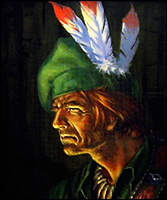 American Heritage Magazine has a great article in their summer 2009 edition which I also found online about one of Major Robert Rogers most daring raids two hundred fifty years ago.
American Heritage Magazine has a great article in their summer 2009 edition which I also found online about one of Major Robert Rogers most daring raids two hundred fifty years ago.
It’s a long article but it will give you a better appreciation of how tough this guy and his men were. It illustrates how Roger’s Rangers turned the tide of the French and Indian War. It’s a great read.
Amelia Earhart & Huletts
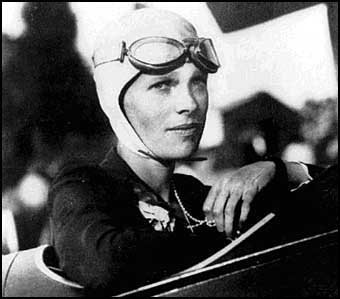
In this book, written by Amelia Earhart’s sister, there is one brief mention of Huletts.
“In the spring of 1919, Mother came to Northhampton from Kansas City. … Mother saw the move from California as another major ordeal that she did not look forward to. We rented a summer home at Huletts’s Landing on Lake George where Amelia, Mother, and I enjoyed the entire summer.”
“Amelia became especially friendly with the New York Stabler family who owned the cottage next door to the one we rented. Another neighbor was a young poet, Mark Turbyfill. Marian Stabler and her brother Frank, Amelia, and I formed a critical yet friendly audience for Mark. Mark’s poetry appealed to us because it broke from traditional poetry both in form and subject.”
That’s all folks. The next paragraph goes on to deal with their father and Amelia’s college career. If anyone knows anything about the people mentioned I’d appreciate hearing from you and I’ll share it here.
Now you know, Amelia Earhart was here in the summer of 1919, exactly 90 years ago!
Now for Some History – 1951
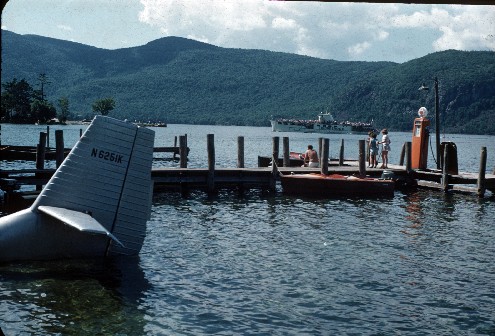
Click the Image to See Full Scale
This was a picture that didn’t make it into my book but because it’s a very early color photo of Huletts, I thought I’d share it here.
Some facts about the Ticonderoga (II)
Year Completed: 1944
Where Built: Bay City, Michigan
Cost to Build: $250,000
Length: 168 feet
Beam: 25′ 6″
Draft: 7′
Displacement: 360 tons
Construction: Steel
Horsepower: 900
Speed: 14 m.p.h.
One Hundred Years Ago – 1909
New York Daily Tribune Sunday July 25, 1909
I have searched for a picture of the baseball team(s) for over ten years. I once came close, finding a picture with players with H’s on their uniforms, but it wasn’t the Huletts team. I’m still searching.
John Paul Jones – Hero of the Seas

A rare photograph of President Theodore Roosevelt speaking in front of the remains of Captain John Paul Jones as his body is re-interred on U.S. soil in 1913.
John Paul Jones (July 6, 1747 – July 18, 1792) was America’s first well-known naval commander in the Revolutionary War. He is regarded as the first leader of America’s navy and is known to have uttered the legendary reply about surrendering to a British captain: “I have not yet begun to fight!”
The historical circumstances regarding his burial and the finding of his body over 100 years later are equally as fascinating.
In May 1790, Jones arrived in Paris, where he remained in retirement during the rest of his life. He died of a severe brain tumor and was found lying face-down on his bed in his third-floor Paris apartment, on July 18, 1792. He was buried in Paris at the Saint Louis Cemetery, which belonged to the French royal family. Four years later, France’s revolutionary government sold the property and the cemetery was forgotten. The area was later used as a garden, a place to dispose of dead animals, and a place where gamblers bet on animal fights.
In 1905, Jones’s remains were identified by the US Ambassador to France who had searched for years to track down the body using old copies of Jones’s burial record. Jones’s body was ceremonially removed from his interment in Paris and brought to the United States aboard the USS Brooklyn, escorted by three other cruisers. On approaching the American coastline, seven U.S. Navy battleships joined the procession escorting Jones’s body back to America.
On April 24, 1906, Jones’s coffin was installed in Bancroft Hall at the United States Naval Academy, Annapolis, Maryland, following a ceremony presided over by President Theodore Roosevelt. On January 26, 1913, the Captain’s remains were finally re-interred in a magnificent bronze and marble sarcophagus at the Naval Academy Chapel in Annapolis.

